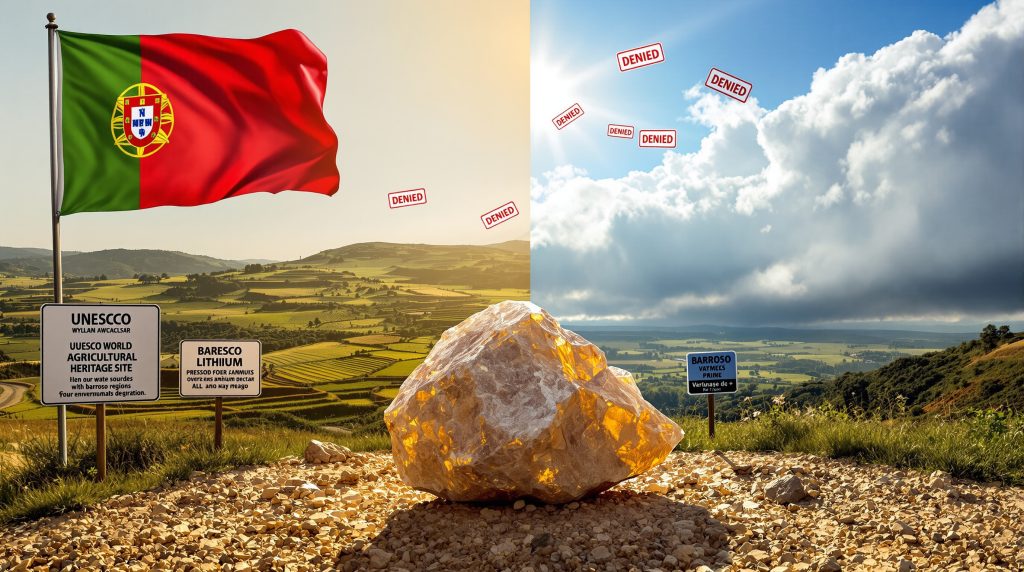How Did Portugal Breach the Aarhus Convention?
Portugal has violated international environmental transparency obligations during the licensing process for Europe's largest lithium mining project, according to the United Nations Aarhus Convention Compliance Committee. This significant ruling found that Portuguese authorities systematically failed in their legal duties to provide citizens with environmental information and participation opportunities.
Portuguese regulatory agencies failed on multiple fronts, including not providing timely access to critical environmental data, ignoring information requests within legally mandated timeframes, failing to inform citizens about their appeal rights when information was denied, and preventing adequate public participation in the environmental decision-making process.
These violations directly contravene Portugal's legal commitments under the 2001 Aarhus Convention, which the country ratified in 2003. This international treaty, now ratified by 47 countries, establishes three fundamental pillars: citizens' rights to environmental information, public participation in environmental decision-making, and access to justice in environmental matters.
Environmental law experts consider the Aarhus Convention one of the most significant international agreements linking environmental rights with human rights. The compliance committee's finding represents a serious precedent, demonstrating the convention's enforcement mechanisms and consequences for countries that fail to uphold transparency obligations.
Timeline of the Transparency Dispute
The chronology of events reveals a prolonged struggle for information access:
-
2018: Barroso region received UNESCO World Heritage site designation for its unique agricultural systems
-
2021: Spanish preservation group Montescola Foundation filed the formal complaint against Portugal
-
2023: Portugal's environmental agency (APA) approved the mining project with conditional requirements
-
2025: UN committee ruled Portugal breached international transparency obligations
The Aarhus Convention requires public authorities to provide environmental information within one month of requests (or two months for complex matters). When information is refused, authorities must provide written justification and inform applicants of their review rights – provisions Portugal failed to honor.
What is the Controversial Barroso Lithium Project?
The Barroso lithium project represents one of Europe's most significant untapped mineral resources, positioned to become a crucial supply source for the continent's growing electric vehicle industry.
Project Specifications and Strategic Importance
London-listed Savannah Resources is developing what would become Europe's largest lithium mining operation, with impressive geological assets:
-
Estimated reserves of at least 28 million metric tons of high-grade lithium
-
The largest spodumene deposit in Europe (spodumene typically contains 6-8% lithium oxide)
-
Planned production start date of 2027
-
Strategic positioning as a key supplier for Europe's electric vehicle battery manufacturing sector
The project's significance extends beyond Portugal, fitting into the European Union's Critical Raw Materials Strategy. The EU has classified lithium as a critical mineral since 2020 and aims to extract 10% of its lithium consumption domestically by 2030, compared to current domestic production of less than 1%.
European demand for lithium is projected to increase by an astonishing 2,100% by 2030, driven by electric vehicle adoption and energy storage requirements. Currently, the EU imports 98% of its lithium, with China controlling approximately 60% of global lithium processing capacity.
Environmental Conditions and Regulatory Oversight
Portugal's environmental agency (APA) granted conditional approval requiring:
-
Implementation of specific environmental remediation measures
-
Compliance with strict water protection protocols
-
Adherence to biodiversity conservation requirements
-
Ongoing environmental monitoring throughout operations
The mining operation will utilize hard rock mining techniques for spodumene extraction, including open-pit operations, crushing, concentration through flotation, and conversion to lithium compounds through high-temperature processing. These processes typically require substantial water usage, with some operations using 500-1,000 cubic meters of water per ton of lithium carbonate produced.
Why Are Local Communities Opposing the Mining Project?
Local opposition to the Barroso lithium project stems from deep concerns about protecting centuries-old agricultural practices and preserving environmental integrity in a region recognized for its cultural significance.
Agricultural Heritage Concerns
The Barroso region holds exceptional cultural and agricultural importance:
-
Designated as a UNESCO Globally Important Agricultural Heritage System (GIAHS) since 2018
-
Home to traditional agro-sylvo-pastoral farming practices dating back more than 4,000 years
-
Supports approximately 1,200 residents across 12 villages, with agriculture as their primary livelihood
-
Features distinctive Barrosã cattle breeds and traditional land management practices
The region's agro-sylvo-pastoral system combines extensive cattle grazing with forest management and small-scale agriculture, creating a mosaic landscape that supports both agricultural production and biodiversity conservation. This system relies on seasonal migration of cattle between valley areas in winter and mountain pastures in summer, following traditional routes unchanged for centuries.
Agricultural heritage specialists emphasize that the GIAHS designation recognizes farming systems that combine agricultural biodiversity, resilient ecosystems, cultural heritage, and landscape beauty. These traditional farming methods often support higher biodiversity levels than intensive agricultural systems while providing critical ecosystem services like carbon sequestration and water regulation.
Environmental Impact Worries
Local residents and environmental organizations have raised numerous concerns:
-
Potential contamination of water resources essential for farming and drinking
-
Disruption of local ecosystems and biodiversity in a recognized biodiversity hotspot
-
Permanent alteration of culturally significant landscapes
-
Cumulative environmental effects from mining operations
Anthropologists studying rural communities note that opposition to mining projects often reflects concerns about cultural continuity and the preservation of traditional livelihoods that have sustained communities for generations. The conflict between agricultural heritage and mineral extraction highlights the challenge of balancing economic development with cultural preservation.
What Water and Biodiversity Risks Does the Project Present?
The environmental stakes in the Barroso mining project are particularly high given the region's ecological significance and water resource vulnerabilities.
Water Resource Vulnerabilities
The mining operation poses several serious water-related challenges:
-
Proximity to important water reservoirs serving local communities and downstream urban areas
-
Documented instances of water springs drying up during exploratory drilling phases
-
Potential for chemical contamination of interconnected groundwater systems
-
Competition for scarce water resources in agricultural areas
Hydrologists studying mining impacts note that lithium extraction operations can significantly affect local water resources through both consumption and potential contamination from processing chemicals. The Barroso region is located within the Peneda-Gerês National Park buffer zone and contains important watersheds that supply water to both local communities and downstream urban areas.
Local water sources include numerous springs and streams that feed into the Cávado River system, which supplies water to over 100,000 people in northern Portugal. The region's granite-based geology creates fracture-flow groundwater systems that can rapidly transport contaminants but are also vulnerable to disruption from surface mining activities.
Biodiversity Conservation Challenges
Environmental assessments have identified significant biodiversity concerns:
-
Mining site located within a recognized biodiversity hotspot
-
Presence of protected and threatened species, including the endangered Iberian wolf
-
Potential habitat fragmentation and destruction of unique ecosystems
-
Concerns about insufficient mitigation measures for wildlife protection
The region supports over 200 bird species, including several protected raptors, and serves as habitat for the endangered Iberian wolf, with an estimated population of 15-20 individuals in the broader area. Biodiversity researchers emphasize that the Barroso region's ecological value extends beyond individual species to encompass landscape-level ecological processes that support regional biodiversity conservation.
Similar environmental challenges have emerged at lithium mining operations worldwide. Water contamination issues from lithium mining have been documented in Chile's Atacama Desert, where brine extraction has lowered water tables and affected local ecosystems. In Australia, spodumene mining operations have faced challenges related to acid mine drainage and heavy metal contamination of surface waters, requiring extensive treatment systems.
How Has the Legal Challenge Unfolded?
The legal battle over the Barroso lithium project has followed a structured international process through the UN's specialized environmental rights mechanism.
The UN Committee's Investigation Process
The complaint against Portuguese authorities followed a methodical path:
-
Filed by Montescola Foundation, a Spanish environmental organization established in 1997 with experience in over 20 cross-border environmental cases in the Iberian Peninsula
-
Support provided by Portuguese environmental groups serving as observers
-
Examination of documentation and permitting process basics by the UN committee
-
Assessment of Portugal's adherence to Aarhus Convention obligations
-
Determination of specific breaches in information access and participation rights
The Aarhus Convention Compliance Committee typically takes 12-18 months to review and decide on complaints. The procedure includes opportunities for written submissions, response periods of typically 3-5 months, and in some cases, hearings or country visits. Compliance determinations are adopted by consensus among the committee's nine members, who serve as independent experts.
International environmental law experts note that while Aarhus Convention compliance findings are not legally binding in the same way as court judgments, they create significant diplomatic pressure for remedial action and can influence domestic legal proceedings.
Conflicting Interpretations of Compliance
The ruling has generated sharply divergent perspectives on regulatory compliance:
| Party | Position on Compliance |
|---|---|
| UN Aarhus Committee | Found Portugal in breach of international treaty obligations |
| Portuguese Environmental Agency (APA) | Claims "strict compliance with administrative procedures" |
| Environmental NGOs | Argue for revocation of environmental permit based on findings |
| Savannah Resources | Declined to comment on the ruling |
The APA stated that despite having a "divergent interpretation" of the convention, it "has always acted in strict compliance with administrative procedures, applying the law" and that all required information had been made available. Environmental groups, however, welcomed the decision and called for the environmental permit to be revoked.
Since the committee's establishment in 2002, it has issued over 180 compliance determinations, with approximately 60% finding at least partial non-compliance by the defendant party. Recent significant compliance findings have included cases against the United Kingdom regarding public participation in planning decisions, against Belarus for restricting NGO activities, and against Armenia for failing to provide access to environmental information.
What Are the Implications for Future Mining Projects?
The UN committee's finding against Portugal could have far-reaching implications for mining projects across Europe, establishing new standards for transparency and public participation.
Precedent for Environmental Transparency
The ruling establishes important precedents for mining projects across Europe:
-
Reinforces public right to access detailed environmental information before decisions are made
-
Emphasizes need for meaningful public participation throughout the licensing process
-
Highlights international scrutiny of environmental decision-making procedures
-
Creates potential legal basis for challenging other mining approvals with similar procedural deficiencies
Mining policy experts argue that the Barroso case could set important precedents for transparency requirements in mining licensing across Europe, potentially extending project development timelines but improving public acceptance. Environmental lawyers suggest that the ruling may encourage more strategic litigation by environmental groups, using international law mechanisms to challenge inadequate consultation processes.
The EU's Environmental Impact Assessment Directive already requires comprehensive public consultation for major mining projects, including mandatory disclosure of technical studies and environmental monitoring data. The Strategic Environmental Assessment Directive also applies to mining policies and programs, requiring assessment of cumulative environmental effects.
Balancing Resource Development and Environmental Protection
The case illustrates the ongoing tension between competing priorities:
-
Strategic mineral development for green technology supply chains
-
Protection of cultural and environmental heritage in rural areas
-
Rights of local communities to participate in decisions affecting their regions
-
International environmental governance frameworks requiring transparent processes
Enhanced transparency measures following legal challenges have been implemented in other EU mining contexts, including strengthened consultation requirements for mining projects in Finland and Sweden. The German mining sector has developed comprehensive public participation protocols following court decisions requiring enhanced transparency in lignite mining licensing.
Industry analysts note that enhanced transparency requirements could increase project costs but may ultimately reduce long-term legal and reputational risks for mining companies. Environmental impact assessments for mining projects in the EU typically take 12-24 months and cost between €500,000-€2 million, depending on project complexity.
How Does This Case Reflect Broader EU Lithium Supply Challenges?
The Barroso lithium dispute highlights Europe's strategic dilemma as it attempts to secure critical minerals security for its green transition while respecting environmental and social considerations.
Strategic Resource Development Pressures
The Barroso project highlights Europe's critical minerals dilemma:
-
EU push for domestic lithium supply to reduce dependency on imports from a concentrated market
-
Urgent need for raw materials to support electric vehicle production and renewable energy storage
-
Pressure to expedite mining projects to meet ambitious climate transition targets
-
Challenge of balancing development speed with environmental and social safeguards
Lithium-ion batteries for electric vehicles require approximately 0.85 kg of lithium carbonate equivalent per kWh of battery capacity, with typical electric vehicles using 50-100 kWh battery packs. The EU's target of 30 million electric vehicles by 2030 would require approximately 1.3-2.6 million tons of lithium carbonate equivalent, representing roughly 25-50% of current global production.
The global lithium market was valued at approximately $7.3 billion in 2022 and is projected to reach $18.2 billion by 2028, driven primarily by electric vehicle battery demand. Global lithium prices increased by over 400% between 2020 and 2022, from approximately $8,000 to $35,000 per ton of lithium carbonate equivalent, highlighting the volatility in this critical market.
Sustainable Mining Standards Evolution
The case may influence development of more robust standards:
-
Greater emphasis on transparency throughout licensing processes
-
Stronger requirements for community consultation and consent
-
More comprehensive environmental impact assessments
-
Improved mechanisms for public participation in decision-making
Supply chain security experts emphasize that Europe's dependence on imported lithium creates vulnerabilities in the transition to electric mobility and renewable energy systems. Geopolitical analysts note that lithium supply concentration in a few countries (Chile, Australia, China) mirrors earlier dependencies on Russian energy that proved problematic during geopolitical tensions.
Other regions facing similar supply chain challenges include North America, where the Inflation Reduction Act provides incentives for domestic lithium production, and Asia, where Japan and South Korea are investing in overseas lithium projects to secure supply. Chile's experience with lithium development shows how environmental and social conflicts can disrupt supply chains, with several projects facing delays due to community opposition and water rights disputes.
What Happens Next in the Barroso Lithium Dispute?
The UN committee ruling opens a new chapter in the Barroso lithium controversy, with multiple potential paths forward for the various stakeholders.
Potential Regulatory Responses
Portuguese authorities now face several possible courses of action:
-
Review and potentially revise the environmental permit in light of the UN findings
-
Implement additional transparency measures for ongoing project oversight
-
Establish improved public information access protocols for future mining applications
-
Address specific deficiencies identified in the UN committee ruling
Aarhus Convention compliance findings typically require respondent countries to submit implementation reports within 12-18 months detailing remedial measures taken. Portugal has previously received two other Aarhus Convention communications, both related to access to justice in environmental matters, with mixed implementation outcomes.
Environmental lawyers suggest that Portuguese courts could consider the UN committee's findings in any domestic legal challenges to the project's permits. The APA processes approximately 200-300 environmental impact assessments annually, with mining projects representing a small but significant portion of these assessments.
Stakeholder Positions and Next Steps
The ruling has reinforced divergent stakeholder positions:
-
Environmental groups are demanding permit revocation based on the findings
-
Local communities are seeking greater voice in the development process
-
Savannah Resources continues project development while addressing conditions
-
Portuguese authorities are balancing strategic mineral development with regulatory compliance
The Montescola Foundation President Joam Evans welcomed the decision, stating the environmental permit should be revoked. Meanwhile, Savannah Resources remains committed to developing the project, aiming to begin production in 2027 to supply Europe's electric vehicle sector.
The case highlights the tension between Europe's strategic minerals agenda and its environmental commitments. The EU has identified over 30 potential lithium projects across 15 countries as part of its Critical Raw Materials Strategy, with total estimated investment requirements of €15-20 billion. However, each project must navigate increasingly complex environmental and social requirements.
FAQ: Portugal's Lithium Mining Environmental Controversy
What environmental laws govern lithium mining in Portugal?
Portugal's mining activities fall under multiple regulatory frameworks including:
-
The Mining Law (Decree-Law 88/90)
-
Environmental Impact Assessment regulations under EU Directive 2014/52/EU
-
Water Framework Directive implementation (Directive 2000/60/EC)
-
The Aarhus Convention on environmental information access
-
Natura 2000 and biodiversity protection legislation
These overlapping frameworks create a complex regulatory environment that requires mining companies to comply with numerous environmental safeguards while also navigating public participation requirements.
How might this ruling affect other European lithium projects?
This precedent-setting case could impact other European lithium developments by:
-
Establishing stronger transparency requirements during permitting processes
-
Increasing scrutiny of public participation procedures
-
Creating legal basis for challenging inadequate information disclosure
-
Potentially extending project timelines to accommodate more thorough consultation
-
Requiring more detailed documentation of environmental decision-making
The ruling may be particularly relevant for projects in Spain, Serbia, and Finland, where similar lithium mining developments are under consideration or in early development stages.
What alternatives exist to large-scale lithium mining in environmentally sensitive areas?
Several alternatives are being explored to reduce dependence on new mining operations:
-
Enhanced lithium recycling from batteries and electronic waste
-
Development of less environmentally disruptive extraction technologies
-
Exploration of lithium resources in less sensitive locations
-
Research into alternative battery chemistries with reduced lithium requirements
-
Urban mining of lithium from industrial waste streams
Recycling technologies have advanced significantly, with new processes able to recover up to 95% of lithium from spent batteries. However, the rapidly growing demand for lithium means recycled materials alone cannot meet projected needs in the near term.
How do Portugal's lithium mining regulations compare to other European countries?
Portugal's regulatory framework differs from other European nations in several ways:
-
Varying requirements for environmental impact assessment scope and public participation
-
Different approaches to community consultation and consent processes
-
Distinct procedures for weighing economic benefits against environmental costs
-
Unique implementation of EU-wide environmental directives
Countries like Finland and Sweden have implemented more extensive community engagement requirements, including specific provisions for indigenous rights. Germany has established more detailed requirements for post-mining restoration and long-term environmental monitoring.
Further Exploration:
Readers interested in learning more about lithium mining environmental regulations can explore the ongoing developments in this case through official UN Aarhus Convention documents and Portuguese environmental agency publications. This evolving situation highlights the complex balance between meeting critical minerals security for the clean energy transition while protecting environmental rights and heritage.
The mining industry evolution continues to face these challenging trade-offs between securing resources for green technology and preserving environmental integrity. As Portugal navigates this controversy, other EU countries are watching closely, with many developing their own lithium industry measures to balance economic opportunity with environmental responsibility. Meanwhile, experts continue to develop new mine reclamation innovations that may help address some of these concerns in future projects.
Want to Get Early Alerts for Major Lithium Discoveries?
Discovery Alert's proprietary Discovery IQ model instantly identifies significant mineral discoveries on the ASX, delivering real-time notifications that could help you capitalise on the next major lithium opportunity before the broader market. Explore how historic discoveries have generated substantial returns by visiting the dedicated discoveries page.




